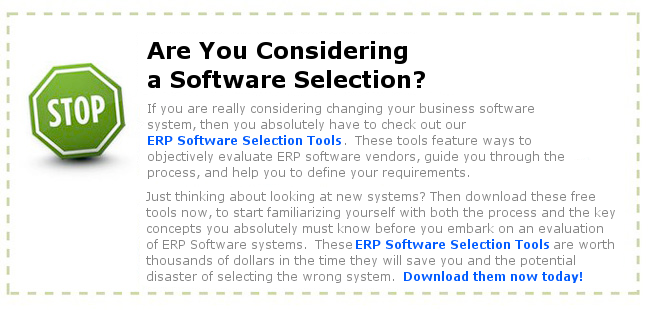There is an article in Eweek about SOA and Software as a Service (SAAS) that discusses the Enterprise vendor’s direction for these two initiatives. From our observations, most middle market companies are not interested in these approaches as they are still struggling with will the software work for our business. Yes, the underpinnings of the ERP are important, but not as much as functionality.
So are SOA and SAAS two flavors of the month? To a certain degree yes. There is so much media hype about how important SOA is to business, yet the key differentiators in ERP selections is still functionality. Are SOA and SAAS important for the future of Enterprise Applications? This has to be yes. Oracle and Microsoft are still just trying to get there various products to talk to one another. They need these two technologies to make a viable “fused and green” product.
But in the end, the customers do not care about these two technologies. They care about something even more basic.. will it work for my business!
(We welcome your comments on this topic! Post them below or in our discussion forum.)
Here is the Eweek article:
Interest in SOA, SAAS Expected to Grow in 2007
By Renee Boucher Ferguson
December 26, 2006
For companies that use enterprise applications from the leading vendors, 2007 to some degree wont offer many surprises. The top vendors—SAP, Oracle and to some degree, Microsoft—will continue investing in service-oriented architectures and will grow their investments in software as a service, according to industry observers.
All three companies will continue their investments in their respective next-generation ERP enterprise resource planning suites, with an underlying middleware platform: mySAP ERP, Oracle Fusion and Microsoft Dynamics.
SAP, of Waldorf, Germany, will offer its first completely SOA-based suite of applications for the mid-market, and Microsoft, of Redmond, Wash., will release Titan, its multi-tenant CRM suite for the mid-market. Both offerings have implications for end users. SAPs hosted suite—the formal announcement is expected in the first quarter of 2007—could impact the mid-market, said Jim Shepherd, an analyst with AMR Research.
“SAP will announce a full mid-market ERP suite that is entirely SOA-based and all new code,” Shepherd said. “The question is if it is enough of a game changer where the mid-market buyer says, I was going to buy [new software] this year, but SAPs suite is not available until 2008. Ill just wait and see. It could freeze the market. We’ve seen it happen before.”
Read the complete article here…
